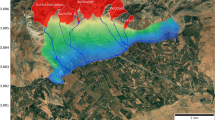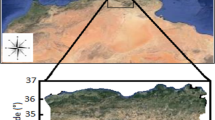Abstract
This paper proposes a surface water extraction method from high-resolution remote sensing images based on an improved U-Net network model. The GF-6 satellite is a significant achievement in optical remote sensing satellites in China, with a spatial resolution of 2 m. Using the high-resolution remote sensing images of a typical area in the southwest of Hefei City, Anhui Province, as experimental data, image cropping, label production, and data augmentation were carried out, and U-Net network was used to mine the deep and shallow features of the images. Firstly, add Dropout and BN layers to improve the training speed and robustness of the model while avoiding overfitting. Next, add the upper-level feature maps in the contraction path to the expansion path to form a dual feature channel fusion mechanism, preventing the loss of detailed information. Finally, rapid surface water recognition was achieved by continuously adjusting parameters to train the network model. The overall recognition accuracy of various objects was 97.99%, the recognition precision rate of target objects was 91.54%, the recall rate was 71.71%, the F1 value was 80.42%, and the Kappa coefficient was 0.90. In addition, the extraction results of this method were compared with other recognition methods such as U-Net, U-Net+, and NDWI, and the results showed that the accuracy, recall rate, and F1 value of the surface water extraction results were improved, with better accuracy.









Similar content being viewed by others
Data availability
The datasets used and/or analyzed during the current study are available from the corresponding author upon reasonable request.
References
An SH, Rui XP (2022) A high-Precision Water body extraction method based on Improved Lightweight U-Net. Remote Sens 14(17):4127. https://doi.org/10.3390/rs14174127
Bi HY, Wang SY, Zeng JY (2012) Comparison and analysis of several common water extraction methods based on TM images. Remote Sens Inform 27(5):77–82. https://doi.org/10.3969/j.issn.1000-3177.2012.05.014
Buchsteiner C, Baur PA, Glatzel S (2023) Spatial analysis of Intra-annual Reed Ecosystem Dynamics at Lake Neusiedl using RGB Drone Imagery and Deep Learning. Remote Sens 15(16):3961. https://doi.org/10.3390/rs15163961
Chen P, Zhang Q, Li Q (2015) Comparative analysis of several commonly used water extraction method based on FY3A/MERSI imagery. Arid Land Geogr 38(4):770–778
Heipke C, Mayer H, Wiedemann C (1997) Evaluation of automatic road extraction. Int Archives Photogrammetry Remote Sens 32(3):151–160
Ioffe S, Szegedy C (2015) Batch normalization: accelerating deep network training by reducing internal covariate shift. Int Conf Mach Learn (ICML). https://doi.org/10.48550/arXiv.1502.03167
Kang YP, Hu XL, Meng QY, Zou YF, Zhang LL, Liu M, Zhao MF (2021) Land cover and crop classification based on Red Edge Indices features of GF-6 WFV Time Series Data. Remote Sens 13(22):4522. https://doi.org/10.3390/rs13224522
Kingma D, BA J (2015) Adam: a method for stochastic optimization. International Conference on Learning Representations(ICLR). https://doi.org/10.48550/arXiv.1412.6980
Kussul N, Lavreniuk M, Skakun S, Shelestov A (2017) Deep Learning Classification of Land Cover and Crop Types Using Remote Sensing Data. IEEE Geoscience and Remote Sensing Letters. vol. 14, no. 5, pp. 778–782. https://doi.org/10.1109/LGRS.2017.2681128
Li L, Ying SC (2017) Implementation of Softmax layer of convolutional neural network based on FPGA. Mod Comput (Pro) 2621–24. https://doi.org/10.3969/j.issn.1007-1423.2017.26.005
Li ZM, Xin QC, Sun Y, Cao MY (2021a) A deep learning-based Framework for Automated extraction of building footprint polygons from very high-resolution aerial imagery. Remote Sens 13(18):3630. https://doi.org/10.3390/rs13183630
Li WN, Li Y, Gong JH, Feng QL, Zhou JP, Sun J, Shi CH, Hu WD (2021b) Urban water extraction with UAV high-resolution remote sensing data based on an improved U-Net model. Remote Sens 13(16):3165. https://doi.org/10.3390/rs13163165
Liu Y, Yao SL, Wang X, Chen J, Li XL (2024) MD-UNet: a medical image segmentation network based on mixed depthwise convolution. Med Biol Eng Comput 62:1201–1212. https://doi.org/10.1007/s11517-023-03005-8
Long LJ, He F, Liu HJ (2021) The use of remote sensing satellite using deep learning in emergency monitoring of high-level landslides disaster in Jinsha River. J Supercomput 77:8728–8744. https://doi.org/10.1007/s11227-020-03604-4
Lu HR, She YF, Tie J, Xu SZ (2022) Half-UNet: a simplified U-Net Architecture for Medical Image Segmentation. Front Neuroinform 16:911679. https://doi.org/10.3389/fninf.2022.911679
McFeeters S (1996) The use of the normalized difference water index(NDWI) in the delineation of open water feature. Internationa J Remote Sens 17(7):1425–1432. https://doi.org/10.1080/01431169608948714
Mei YQ, Fan YC, Zhou YQ, Huang LC, Huang T, Shi HH (2020) Image Super-Resolution with Cross-Scale Non-Local Attention and Exhaustive Self-Exemplars Mining. 2020 IEEE/CVF Conference on Computer Vision and Pattern Recognition pp 5689–5698. https://doi.org/10.1109/CVPR42600.2020.00573
Olaf R (2015) U-Net: Convolutional Networks for Biomedical Image Segmentation. Medical Image Computing and Computer-Assisted Intervention-MICCAI 2015. 18th International Conference. https://doi.org/10.48550/arXiv.1505.04597
Park S, Song A (2024) Shoreline change analysis with Deep Learning Semantic Segmentation using remote sensing and GIS data. KSCE J Civ Eng 28:928–938. https://doi.org/10.1007/s12205-023-1604-9
Shafiq M, Gu Z (2022) Deep residual learning for image recognition: a Survey. Appl Sci 12(18):8972. https://doi.org/10.3390/app12188972
Shelhamer E, Long J, Darrell T (2017) Fully Convolutional Networks for Semantic Segmentation. IEEE Transactions on Pattern Analysis and Machine Intelligence, vol. 39, no. 4, pp. 640–651. https://doi.org/10.1109/TPAMI.2016.2572683
Shi TT, Guo ZH, Li CH, Lan XT, Gao X, Yan X (2023) Improvement of deep learning method for water body segmentation of remote sensing images based on attention modules. Earth Sci Inf 16:2865–2876. https://doi.org/10.1007/s12145-023-00988-8
Shun Z, Li DY, Jiang HB, Li J, Peng R, Lin B, Liu QL, Gong XY, Zheng XZ, Liu T (2022) Research on remote sensing image extraction based on deep learning. PeerJ Comput Sci 8:e847. https://doi.org/10.7717/peerj-cs.847
Srivastava N, Hinton G, Krizhevsky A, Sutskever I, Salakhutdinov R (2014) Dropout: a simple way to prevent neural networks from overfitting. J Mach Learn Res 15(1):1929–1958
Sun K (2018) IGCV3: interleaved low-Rank Group convolutions for efficient. https://doi.org/10.48550/arXiv.1806.00178. Deep Neural Networks
Wang ZQ, Zhou Y, Wang SX (2021) IEU-Net high resolution remote sensing image building extraction. J Remote Sens 25(11):2245–2254. https://doi.org/10.11834/jrs.20210042
Wang XX, Lu XP, Zhang XJ, Yang ZN (2022) Inversion of the hybrid machine learning model to estimate leaf area index of winter wheat from GaoFen-6 WFV imagery. Geocarto Int 37(27):16307–16322. https://doi.org/10.1080/10106049.2022.2108906
Wei XB, Zhang W, Zhang Z, Huang HS, Meng LK (2023) Urban land use land cover classification based on GF-6 satellite imagery and multi-feature optimization. Geocarto Int 38(1):1–24. https://doi.org/10.1080/10106049.2023.2236579
Xiang S, Wang M, Jiang XF, Xie GQ, Zhang ZQ, Tang P (2021) Dual-Task Semantic Change Detection for Remote sensing images using the Generative Change Field Module. Remote Sens 13:3336. https://doi.org/10.3390/rs13163336
Xu HQ (2005) A study on Information Extraction of Water Body with the modified normalized Difference Water Index (MNDWI). J Remote Sens 5589–595. https://doi.org/10.11834/jrs.20050586
Xu B, Wang N, Chen T, Li M (2015) Empirical evaluation of rectified activations in Convolutional Network. https://doi.org/10.48550/arXiv.1505.00853. Computer ence
Xu YY, Wu L, Xie Z, Chen ZL (2018) Building extraction in very high resolution remote sensing imagery using deep learning and guided filters. Remote Sens 10:144. https://doi.org/10.3390/rs10010144
Yan JN, Wang LZ, He HX, Liang D, Song WJ, Han W (2022) Large-Area Land-Cover Changes Monitoring With Time-Series Remote Sensing Images Using Transferable Deep Models. IEEE Transactions on Geoscience and Remote Sensing, vol. 60, pp. 1–17, Art no. 4409917. https://doi.org/10.1109/TGRS.2022.3160617
Yang Y, Ruan RZ (2010) Research on water information extraction in plain lakes based on TM images [J]. Remote Sens Inform 25(3):60–64. https://doi.org/10.3969/j.issn.1000-3177.2010.03.013
Yang F, Men XZ, Liu YS, Mao HG, Wang YN, Wang L, Zhou XR, Niu C, Xie X (2023) Estimation of landslide and Mudslide susceptibility with multi-modal remote Sensing Data and Semantics: the case of Yunnan. Mountain Area 12(10):1949. https://doi.org/10.3390/land12101949
Yue RH (2010) Land cover classification of Mongolian plateau based on MODIS data. https://doi.org/10.7666/d.y1708381. Inner Mongolia Normal University
Yue H, Li Y, Qian JX, Liu Y (2020) A new accuracy evaluation method for water body extraction. Int J Remote Sens 41:19:7311–7342. https://doi.org/10.1080/01431161.2020.1755740
Zeng YF, Guo Y, Li JY (2022a) Recognition and extraction of high-resolution satellite remote sensing image buildings based on deep learning. Neural Comput Applic 34:2691–2706. https://doi.org/10.1007/s00521-021-06027-1
Zeng ZH, Fan CD, Xiao LY, Qu XL (2022b) DEA-UNet: a dense-edge-attention UNet architecture for medical image segmentation. J Electron Imaging 31(4):043032. https://doi.org/10.1117/1.JEI.31.4.043032
Zhang HJ, Ye CM, Zhou YZ, Tang R, Wei RL (2023) A Super-resolution Network for High-Resolution Reconstruction of Landslide Main bodies in Remote sensing Imagery using coordinated attention mechanisms and deep residual blocks. Remote Sens 15:4498. https://doi.org/10.3390/rs15184498
Zhao BY, Wu JJ, Han XY, Tian F, Liu MX, Chen M, Lin JY (2023) An improved surface water extraction method by integrating multi-type priori information from remote sensing. Int J Appl Earth Obs Geoinf 124:103529. https://doi.org/10.1016/j.jag.2023.103529
Acknowledgements
The authors are grateful to the financial support for this project from the National Natural Science Foundation of China (Grant No. 41972304) & 2023 Natural resources monitoring remote sensing new technical services and monitoring results analysis and report preparation(Grant No. 2023BFAFN00941). We also thank Anhui province fourth surveying and mapping Institute for providing the data.
Funding
This work was financially supported by the National Natural Science Foundation of China (Grant No. 41972304) & 2023 Natural resources monitoring remote sensing new technical services and monitoring results analysis and report preparation(Grant No. 2023BFAFN00941).
Author information
Authors and Affiliations
Contributions
Guoqing Wang and Guoxu Chen conceived the manuscript; Guoxu Chen, Li’ao Quan, Er’rui Ni and Jianxin Zhang provided funding support; Guoqing Wang and Bin Sui were responsible for researching methods, algorithms and model construction; Guoxu Chen provided the data used in this research; Guoxu Chen and Guoqing Wang helped to improve the manuscript. All authors have read and agreed to the submitted version of the manuscript.
Corresponding author
Ethics declarations
Competing interests
The authors declare no competing interests.
Additional information
Communicated by H. Babaie.
Publisher’s Note
Springer Nature remains neutral with regard to jurisdictional claims in published maps and institutional affiliations.
Rights and permissions
Springer Nature or its licensor (e.g. a society or other partner) holds exclusive rights to this article under a publishing agreement with the author(s) or other rightsholder(s); author self-archiving of the accepted manuscript version of this article is solely governed by the terms of such publishing agreement and applicable law.
About this article
Cite this article
Wang, G., Chen, G., Sui, B. et al. Surface water extraction from high-resolution remote sensing images based on an improved U-net network model. Earth Sci Inform (2024). https://doi.org/10.1007/s12145-024-01306-6
Received:
Accepted:
Published:
DOI: https://doi.org/10.1007/s12145-024-01306-6




